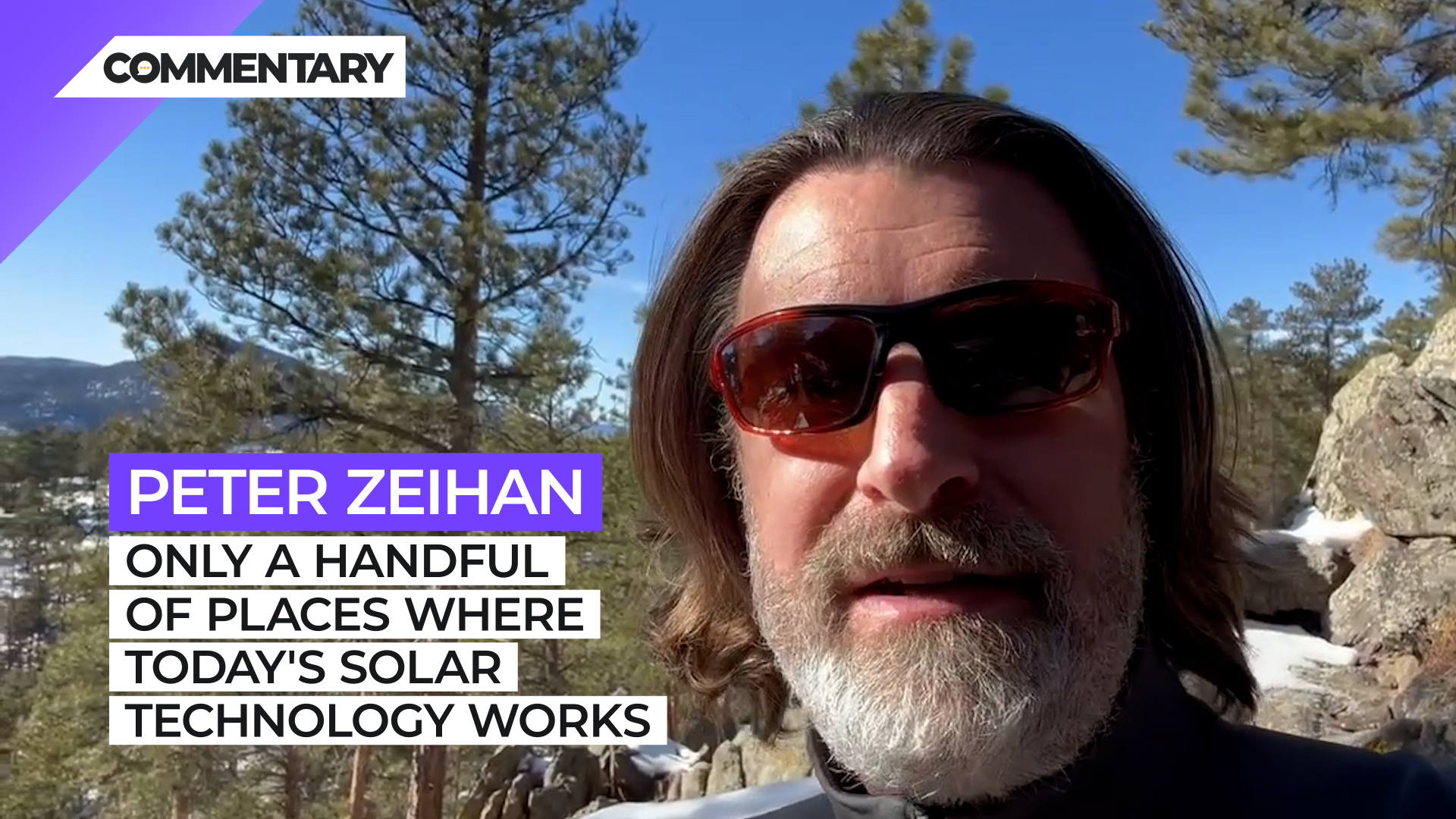
Commentary
-
Our commentary partners will help you reach your own conclusions on complex topics.
Hey, everybody, hello from Colorado, Peter Zeihan here. Today I wanted to talk about solar. Since it’s a sunny day,
I am green, but I’m a green who can do math. So I don’t get invited to really any of the green parties. Solar is great. If you know, if you have one of those – a sun. Not just you have to have one for your planet, you have to be able to see it regularly. Solar intensity around the world varies by an order of magnitude based on where you are. And if your goal is to both generate a meaningful amount of electricity and reduce your carbon footprint. There are only a handful of places where today’s solar technology really work. Well, now I live in one of them. Denver is the sunniest city in the United States, and people like Oh, Shouldn’t that be Phoenix who doesn’t know, because there’s more things that go in there than temperature, humidity, air density, wind patterns, weather and patterns. Denver sits on the lee side of the Rocky Mountains. So it’s in the rain shadow of the largest mountain range on the continent. And it gets its weather in two phases, either storms that blow in from the mountains, or storms that blow off the Great Plains. In both cases, the storms tend to be cold fronts. So they whip through fast, they drop a lot of rain or snow and then they move on leaving clear air behind. If you’re in Phoenix, you’re going to be dealing with a lot of particulate matter because of the dry desert nature of the place. And a lot of smog, if you’re in Dallas Fort Worth, you’re dealing with humidity, there just aren’t very many places in the world that have a really good solar quotient.
And in the United States, you’re pretty much talking about the California coastline into Southern California and then into the desert southwest. And there’s this little hook up the east side of the Front Range, which is where I live. In fact, I’m one up on Denver, because I’m at 7500 feet. So we regularly get snow in our valleys and fog in our valleys and Denver will get fogged in. But I am a half a vertical mile above Denver. And so it is very rare for my neighborhood to be fully cloudy for a whole day. It only happens about 20 or 30 days a year, as opposed to when you have an atmospheric haze, which in most populated parts of the world lasts pretty much you know entire seasons. That means that my panels if you were to put them in New York, only generate about a quarter of the power that they generate for me. Put that in Toronto, you’re down to one-fifth.
You put it in Berlin, down to one-sixth. As a rule, most of human population, most notably in southeast China, or excuse me, in the East Chinese coast, Northern Europe and Northeast United States, you put up solar panels, you are most likely generating more carbon from the creation of the panel and transmission system than you will ever pay down from the electricity that you generate. So you’re actually contributing to the problem rather than solving it. Which brings us to a second problem. I live in a rural area. So I’ve got a big roofline. And I have an 11.5 kilowatt solar system, which is about the maximum that Colorado allows when you’re going to do a feed in tariff, which is a fancy way of saying that you pay into the grid with electricity, the same rate that they charge you to get it out.
It’s a great system we’ve got here in rural Colorado. Most cities don’t have that option. Number one, you’re going to have to have a more profit-driven electrical system, I work with a co-op, which means they’re not going to give you as generous of feeding rates. And second, cities by their very definition are densely populated. Solar by its very nature has to be distributed. So yes, if you live in a traditional single family neighborhood, with homes with sizable roof lines and a lot of south-facing frontage, you may may be able to have a decent solar quotient for your system, especially if you live in the American Southwest or California.
But if you live in a mid rise, much less a high rise, much less than a cannulated city like Chicago or New York, there’s nowhere to put the panels in the first place, you’re gonna have to put them outside of the city. And now you’re talking about transmission costs. And if you’re in New York, you’re not going to put it outside of City of New York, because that’s equally cloudy, you’re gonna have to go down to like Central Virginia, and then there’s a half a dozen major cities between you and where you’re gonna be pulling your power from.
It’s not that solar can’t be part of the solution; it can. But it really only works in some very specific geographies, like where I live where it works really well. For us to fix this three things need to change number one, we need panels that capture more of the sun and translate more of its energy into electricity. The rate of recovery for that has been incrementally going up for a while now. There is now panels on the drawing board and not on production on the drawing board. They can capture as much as half, that’s great, huge step in the right direction.
But you also then treat me transmission to get it from where places that are sunny and you put up your solar panels to where people actually live. And to do that at scale. We’re not just talking about high voltage lines at across state lines, we’re talking about relatively room temperature semiconductors. And for those of you been following some of my other energy work, you know the same thing as Bessie, basically necessary for new fusion power as well, single large facilities that you want nowhere near city that can transport the power over hundreds of miles if necessary. But the third thing, that’s probably going to be the most problematic in the near term, and that’s capital.
When you put up a solar farm, or wind farm, or any sort of green tech, you have to pay for it up front, which means you have to finance it. If you’re putting up a coal and natural gas plant, most of the cost of operating that plant over its lifespan is in fuel. So you pay for that as you go, the financing needs are not nearly as much. And with the baby boomers moving into mass retirement and liquidating all of their high velocity capital, other stocks, all their bonds, everything’s going into tea bills, and cash. And the volume of capital that is available to finance green tech projects just isn’t going to be there at the scale we’ve become used to. And that’s not just for green tech, that’s for everything from car loans to borrowing to pay for Super carriers.
Everything is going to get more expensive to finance. And since green tech must be financed up front, it is going to be the economic sub sector that’s probably going to suffer most dramatically over the next few years. Unless the technology changes. You change that technology on me I reserve the right to change my mind. All right. That’s it for me. Until next time.
-
Hurricane Helene hits US coast, Appalachia and beyond
Hurricane Helene hit Florida and Georgia overnight between Sept. 26 and 27 as a Category 4 hurricane, and accompanying storms will continue reaching deeper into the continental United States today. Dangerous flash flooding from the hurricane, known as storm surge, was some of the worst flooding that the Tampa Bay area has ever seen, and… -
Israel holds upper hand against Lebanon, Hezbollah and Iran
On Wednesday, Sept. 25, Hezbollah launched a ballistic missile at Tel Aviv in retaliation for Israel’s explosive pager attack that blew up devices across Lebanon. Although Israel’s defense systems intercepted the surface-to-surface missile, the attempted strike on Tel Aviv marked a significant escalation by Hezbollah. Since the siege on Gaza began, shortly after the Oct. 7, 2023,… -
The Sinaloa Cartel civil war
Fears of a civil war within the Sinaloa Cartel are growing as violence between competing factions within the cartel continues. The Mexican Army has dispatched around 600 elite troops to Sinaloa to help quell those fears, in addition to roughly 2,200 regular soldiers and National Guard. Watch the above video as Straight Arrow News contributor… -
New Ukrainian weapons hit Russia where it hurts
Ukrainian drones struck a major Russian ammunition depot, triggering a massive explosion that was captured on camera. According to the Ukrainian military, 2,000 tons of munitions had arrived at the depot before the attack. Over the past two years, Ukraine has significantly increased its domestic drone production, allowing it to scale up attacks on military… -
Weighing social costs vs. economic benefits on immigration
Global human migration is one of the defining elements of our current historical era, according to the United Nations. Migrants face both the incentives to leave — forced out by climate change, crime and corruption, extreme poverty or violence — and incentives for where to go, based on available job opportunities and so on. Migration…
Latest Stories
-
 Getty Images
Getty Images
Jay-Z sues sexual assault accuser and lawyer, says Roc Nation lost $20 million
-
 Getty Images
Getty Images
Democrats want DOJ attorney who dropped Eric Adams case investigated
-
 Getty Images
Getty Images
Millions of users’ personal data shared with US law enforcement: Report
-
 Getty Images
Getty Images
Republican leaders urge a pause on town hall meetings
-
 Getty Images
Getty Images
Media spins Trump, Zelenskyy Oval Office meeting: Bias Breakdown
Popular Opinions
-
In addition to the facts, we believe it’s vital to hear perspectives from all sides of the political spectrum.
Latest Opinions
In addition to the facts, we believe it’s vital to hear perspectives from all sides of the political spectrum. We hope these different voices will help you reach your own conclusions.
The opinions published in this section are solely those of the contributors and do not reflect the views of Straight Arrow News.





















Latest Commentary
We know it is important to hear from a diverse range of observers on the complex topics we face and believe our commentary partners will help you reach your own conclusions.
The commentaries published in this section are solely those of the contributors and do not reflect the views of Straight Arrow News.
Dr. Frank Luntz
Pollster and Political Analyst‘Biased’: What Americans think of ‘mainstream media’
‘Getting rid of them’: Americans discuss Trump and immigration
‘Woke’: Why some Biden 2020 voters backed Trump in 2024